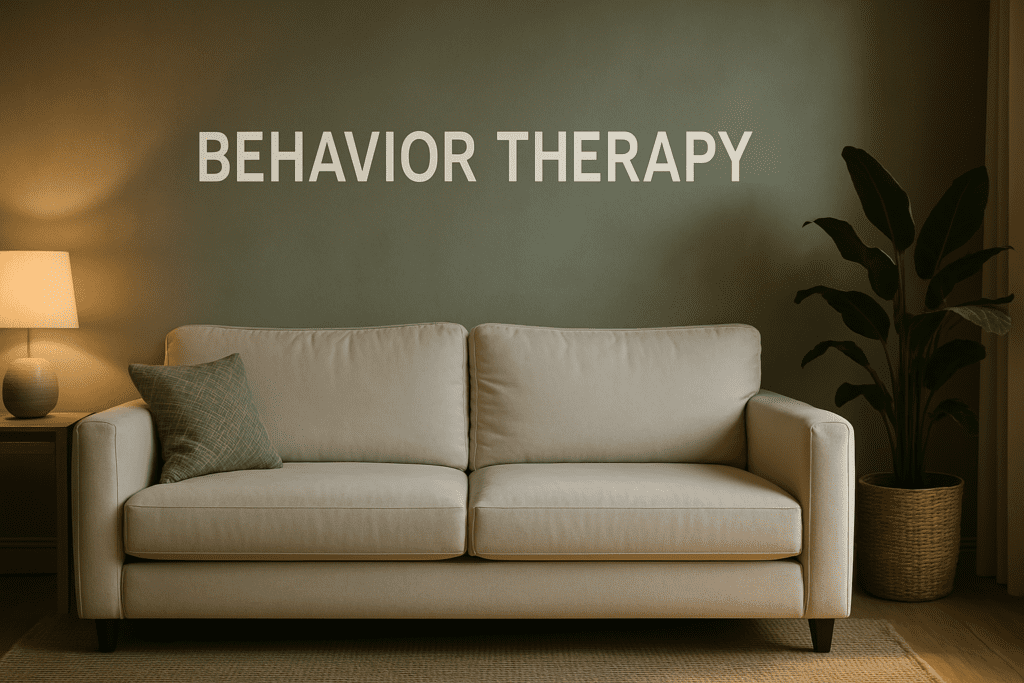Behavioral therapy has become one of the most well-established approaches in modern psychology, especially in treating a range of mental health conditions. Yet many individuals still wonder, “What does a behavioral therapist do?” This question is more than just a request for a job description—it reflects a broader need to understand the practical value, methods, and scientific principles that underpin behavioral therapy today. Behavioral therapists work at the intersection of human behavior, emotional health, and applied psychological science, helping clients modify unhelpful behaviors to improve overall well-being. As awareness of mental health continues to grow, so does interest in behavioral approaches, particularly for adults coping with anxiety, depression, trauma, and other challenges. To appreciate the role of a behavioral therapist, one must delve into the various types of behavioral therapy, the therapeutic goals that drive these methods, and the science-based benefits that make this approach both effective and empowering.
You may also like: How Does CBT Work to Improve Relationships and Communication? Science-Backed Techniques for Getting Along with Others
Defining Behavior Therapy: Foundations and Evolution
To define behavior therapy is to explore a field rooted in observable actions, scientific rigor, and practical outcomes. The behavioral therapist definition originates from early 20th-century psychological research, especially within the realms of classical and operant conditioning. Unlike psychodynamic approaches that focus on unconscious processes, behavioral therapy is based on the idea that behaviors are learned responses to the environment and can thus be changed through specific techniques. In fact, the behavior therapy psychology definition emphasizes the use of empirically supported interventions to alter maladaptive behaviors. Behavioral therapies use applications of conditioning principles to target unwanted behaviors and replace them with healthier alternatives. This model stands in contrast to traditional talk therapy by focusing less on introspection and more on action-oriented strategies.
The behavioral theory in counselling evolved from foundational figures like B.F. Skinner and John B. Watson, who emphasized measurable behavior over abstract mental states. Over time, behavioral therapy expanded to integrate cognitive elements, eventually leading to the rise of cognitive-behavioral therapy (CBT). Still, traditional behavior therapy remains a distinct and valuable modality. Behavioral methods continue to prove useful in structured therapeutic environments, particularly for adults seeking concrete skills to manage anxiety, anger, phobias, and other behavioral concerns. Behavioral therapy is based on the premise that change is possible through active participation and practice—an approach that resonates strongly with adults striving for practical improvement in their lives.
What Does a Behavioral Therapist Do?
A behavioral therapist plays a pivotal role in guiding clients toward behavioral change. Their work begins with thorough assessments to identify patterns, triggers, and consequences of problematic behaviors. From there, the therapist collaborates with the client to set clear, measurable goals. Central to the answer to “what does a behavioral therapist do” is the use of evidence-based strategies that reinforce desired behaviors and diminish undesired ones. These may include reinforcement schedules, exposure techniques, role-playing, skills training, and systematic desensitization. Rather than dwelling on past trauma or unresolved conflicts, the behavioral therapist emphasizes present-moment functioning and future-oriented growth.
One of the defining qualities of a behavior management therapist is their structured, goal-oriented approach. Whether working in a clinical setting, school, correctional facility, or private practice, behavioral therapists tailor interventions to suit the specific needs of each client. They may help an adult manage compulsive behaviors, cope with social anxiety, develop assertiveness, or overcome procrastination. The therapeutic goals of behavior therapy are always concrete and action-driven, such as reducing the frequency of panic attacks, improving communication, or increasing task completion at work. This emphasis on practical change aligns with the behavioral therapy psychology definition, which underscores observable, measurable outcomes as the markers of success.
Types of Behavioral Therapy for Adults
Understanding the types of behavioral therapy used with adults reveals the diversity and adaptability of this therapeutic framework. One of the most commonly recognized forms is Applied Behavior Analysis (ABA), often associated with developmental disorders but also useful in modifying adult behaviors in structured settings. Exposure therapy, another subtype, is particularly effective for treating phobias, obsessive-compulsive disorder, and PTSD. It involves gradually and systematically exposing clients to feared stimuli while helping them develop coping skills. Behavioral conditioning therapy, grounded in classical and operant conditioning principles, targets the reinforcement mechanisms that sustain problematic behaviors and replaces them with healthier responses.
Dialectical Behavior Therapy (DBT), though technically a hybrid of behavioral and cognitive approaches, retains a strong behavioral foundation. It teaches adults skills for emotional regulation, distress tolerance, mindfulness, and interpersonal effectiveness—making it particularly useful for borderline personality disorder and chronic emotional dysregulation. Another subtype, Acceptance and Commitment Therapy (ACT), encourages clients to accept difficult emotions while committing to behaviors aligned with personal values. These types of behavioral therapy demonstrate that behavioral methods are not one-size-fits-all. Instead, they can be tailored to meet the complex needs of adults across different life circumstances and clinical diagnoses.
Behavioral therapists also draw from social learning theory, which highlights the role of modeling and observational learning in behavior change. This approach can be especially beneficial in group therapy settings, where clients learn through interaction and feedback. Regardless of the specific method used, behavior therapies in general emphasize the importance of consistency, repetition, and reinforcement. These strategies are central to creating lasting change and helping clients achieve their therapeutic goals.
Therapeutic Goals of Behavior Therapy
At the core of every behavioral intervention are the therapeutic goals of behavior therapy. These goals are always concrete, observable, and designed to produce measurable change. Unlike more abstract or insight-oriented therapies, behavioral therapy focuses on reducing maladaptive behaviors and increasing adaptive ones. For adults, this might include developing healthier sleep patterns, eliminating avoidance behaviors, or enhancing time management skills. Each goal is rooted in a collaborative treatment plan developed by the therapist and client, often using tools such as behavior tracking, homework assignments, and structured exercises.
A behavior management therapist often works with clients to identify specific problems that interfere with daily functioning. For example, someone struggling with anger outbursts may be guided to develop alternative coping responses, track triggering situations, and practice de-escalation strategies in real-life contexts. Behavioral therapy focuses on small, incremental changes that build toward broader life improvements. This step-by-step model can be particularly motivating for adults who may feel overwhelmed by the idea of wholesale transformation. Behavioral therapy is based on the idea that progress is cumulative—each behavioral success strengthens the client’s sense of self-efficacy and motivation.
Another key therapeutic goal is generalization, which refers to the ability to transfer skills learned in therapy to other areas of life. This is crucial for long-term success. For example, an adult who learns assertiveness skills in therapy should be able to use them both at work and in personal relationships. Behavioral therapists also aim to help clients prevent relapse by teaching them to anticipate challenges and develop contingency plans. Ultimately, the therapeutic goals of behavior therapy are not just about symptom reduction—they are about enhancing autonomy, resilience, and quality of life.
Behavior Therapy Focuses on Action Over Insight
One of the defining aspects of behavioral therapy is its focus on action rather than insight. This does not mean that self-awareness is unimportant, but rather that behavioral therapy operates under the assumption that changing behavior can lead to cognitive and emotional shifts, not the other way around. This action-oriented approach can be especially empowering for adults who feel stuck in cycles of rumination or hopelessness. Behavioral therapy focuses on teaching clients specific skills—such as relaxation training, assertiveness, or exposure techniques—that they can use immediately in their daily lives.
This practical orientation is one reason why behavioral therapy is often used in time-limited formats, such as brief therapy models. Clients are encouraged to experiment with new behaviors, gather feedback from their environment, and adjust their strategies accordingly. This trial-and-error process reinforces the idea that change is possible and within the client’s control. Behavioral methods emphasize the role of environmental cues and consequences in shaping behavior, which allows clients to develop a more nuanced understanding of how their surroundings influence their actions. Behavioral therapies use applications of structured experimentation to support sustainable change.
In addition, the emphasis on behavior rather than inner states makes behavioral therapy highly compatible with workplace coaching, education, and other non-clinical environments. Adults who prefer a clear roadmap to improvement often find this approach refreshing. It eliminates the ambiguity that can sometimes accompany more exploratory forms of therapy and replaces it with a results-driven methodology. Whether the goal is to reduce smoking, manage anger, or improve sleep hygiene, behavioral therapy provides a straightforward path forward.

Benefits of Behavioral Therapy for Adults
The benefits of behavioral therapy for adults are well-supported by decades of research and clinical practice. Among the most compelling is the therapy’s strong empirical foundation, which provides clients with reassurance that they are engaging in a scientifically validated process. Behavioral therapy is particularly effective for treating anxiety disorders, depression, obsessive-compulsive behaviors, and substance use disorders. Because the interventions are evidence-based, progress is often measurable and trackable, making it easier for both clients and therapists to evaluate success.
Another benefit is the focus on skill-building. Many adults enter therapy not just seeking relief from symptoms but also hoping to gain tools for navigating future challenges. Behavioral therapy equips individuals with a repertoire of coping strategies that can be adapted across different situations. For example, a client who learns behavioral activation to manage depression can use similar principles to address job burnout or relationship difficulties. Behavioral therapy focuses on functional improvement rather than diagnostic labels, which makes it broadly applicable across diverse populations.
There is also a growing recognition of how behavioral therapy supports autonomy and agency. Instead of positioning the therapist as a guru or sole expert, the behavioral model encourages collaboration and self-direction. This fosters a sense of empowerment in clients, who are treated as active participants in their own healing. Behavioral therapies use applications of reinforcement, practice, and feedback to help individuals become the agents of their own change. As a result, clients often experience improvements in self-esteem, confidence, and motivation alongside symptom reduction.
Behavioral Theory in Counselling Practice
The behavioral theory in counselling continues to evolve as new research sheds light on how people learn, change, and maintain behaviors over time. Originally centered on stimulus-response models, modern behavioral theory incorporates complex understandings of motivation, cognition, and social learning. Behavioral therapists use these insights to develop nuanced interventions tailored to individual client needs. For example, an adult struggling with panic disorder may benefit from a combination of exposure therapy and cognitive restructuring, while another may require assertiveness training and habit reversal techniques.
Behavioral therapists also use functional analysis to examine the antecedents and consequences of a behavior. This allows them to pinpoint the environmental and psychological factors that maintain problematic patterns. By identifying what reinforces a behavior—whether it’s attention, avoidance, or relief—therapists can create strategies to disrupt the cycle and promote alternative responses. This analytic approach is especially helpful for adults with entrenched behavior patterns or co-occurring conditions.
Behavioral theory in counselling also informs how therapists structure sessions, provide feedback, and measure progress. Sessions are typically focused, time-bound, and organized around specific goals. Clients are often given homework assignments that reinforce skills learned during the session, and progress is routinely reviewed. This structured approach appeals to adults who appreciate clarity, consistency, and accountability. Ultimately, behavioral theory provides a robust framework for helping individuals create meaningful, lasting change.
Understanding the Behavioral Therapist Definition in Practice
The behavioral therapist definition goes far beyond a job title—it encompasses a set of principles, strategies, and ethical commitments that guide therapeutic work. A behavioral therapist is trained to assess, plan, implement, and evaluate interventions that target specific behavioral goals. They may work independently or as part of a multidisciplinary team that includes psychiatrists, social workers, occupational therapists, and educators. Their role is especially vital in settings where structure, accountability, and evidence-based practices are critical.
Behavioral therapists are also skilled at translating complex psychological concepts into accessible, actionable guidance. Whether they are working with an adult client in a private practice or a student in an academic setting, their goal is to empower the individual through clear strategies and compassionate support. They must also adhere to high standards of ethical practice, including informed consent, data privacy, and evidence-based care. Behavioral methods require both technical expertise and a deep understanding of human behavior in real-world contexts.
A behavior management therapist may specialize in helping clients regulate impulsive actions, navigate interpersonal conflicts, or meet developmental milestones. In each case, the therapist’s job is not just to treat symptoms but to foster lasting change through consistency, accountability, and empathy. Behavioral therapies use applications of learning theory, conditioning, and reinforcement to achieve therapeutic goals that matter to the client. This commitment to client-centered care is what defines excellence in behavioral therapy.

Frequently Asked Questions About Behavioral Therapy for Adults
1. How does behavioral therapy adapt to neurodiverse adults, such as those with ADHD or autism?
Behavioral therapy adapts to neurodiverse adults by customizing interventions based on individual cognitive profiles, learning styles, and sensory sensitivities. For instance, a behavioral management therapist working with an adult with ADHD might emphasize environmental structuring and positive reinforcement to improve task initiation and focus. In autism spectrum presentations, behavioral conditioning therapy may involve visual supports and structured routines to reduce anxiety and enhance communication skills. The behavioral therapist definition in this context includes a deep understanding of neurocognitive variation and functional behavior analysis. These personalized strategies reflect how behavioral therapy is based on observing patterns and applying adaptive behavioral methods that respect neurological diversity.
2. Can behavioral therapy be effectively delivered through digital or telehealth platforms?
Yes, digital behavioral therapy has grown rapidly in effectiveness, especially with advancements in secure telehealth platforms. Virtual sessions can accommodate structured behavioral methods such as skills training, exposure tasks, and reinforcement planning. A behavior management therapist may use screen-sharing tools for real-time modeling or cognitive rehearsal, while asynchronous tools like mobile tracking apps help reinforce between-session accountability. The core behavioral therapy psychology definition remains unchanged in telehealth—the focus still centers on observable actions and goal-setting—but delivery methods evolve with technology. Behavioral therapies use applications of video modeling and gamified reinforcement to maintain client engagement in remote formats.
3. What are some lesser-known types of behavioral therapy and when are they most effective?
While cognitive-behavioral therapy and exposure therapy are well-known, lesser-known types of behavioral therapy include habit reversal training (HRT), behavioral activation (BA), and contingency management. Habit reversal training is effective for body-focused repetitive behaviors like trichotillomania or nail-biting. Behavioral activation is highly useful in depression treatment, as it increases engagement with rewarding activities. Contingency management, often applied in substance use treatment, uses tangible rewards to reinforce abstinence or treatment adherence. Each of these reflects how behavior therapy is based on reinforcement theory and the behavioral theory in counselling practice. By aligning interventions with client-specific needs, these behavioral methods can be tailored for nuanced, real-world results.
4. How does behavioral therapy integrate with medication or other psychiatric treatments?
Behavioral therapy often complements pharmacological interventions, creating a more comprehensive treatment plan. For example, a behavioral therapist might collaborate with a psychiatrist to reinforce medication adherence by using behavior contracts or reminder systems. Behavioral therapies in general emphasize skill acquisition and environmental restructuring, which can mitigate side effects or enhance the functional impact of medications. For adults managing chronic anxiety or depression, behavioral therapy focuses on routine-building and exposure to positive stimuli that support neurochemical regulation. This integrated care model respects the therapeutic goals of behavior therapy while acknowledging that some clients may benefit from multimodal treatment.
5. Are there specific benefits of behavioral therapy for adults in high-stress professions?
Behavioral therapy is particularly useful for adults in high-stress professions such as healthcare, law, education, or emergency response. It offers evidence-based tools to manage burnout, increase performance, and reduce maladaptive coping strategies. A behavioral therapist may teach stress-response planning, behavioral activation for motivation, or assertiveness training for workplace boundaries. The benefits of behavioral therapy in this context extend beyond symptom management—they foster resilience, strategic thinking, and emotional regulation under pressure. These outcomes exemplify how behavioral therapies use applications of behavioral conditioning to shift both personal and professional behaviors toward greater efficiency and well-being.
6. How does behavioral therapy address relational dynamics, such as communication or conflict resolution?
Behavioral therapy can be highly effective in improving relationship patterns, especially when addressing communication breakdowns or repetitive conflict. The behavioral theory in counselling suggests that interpersonal behaviors—like passive-aggression, criticism, or avoidance—are learned and reinforced over time. A behavioral therapist might use role-playing, reinforcement strategies, or behavioral rehearsal to teach new ways of engaging with partners, family, or coworkers. These behavioral methods help adults replace reactionary responses with assertive, intentional communication. Behavior therapy focuses on real-time skill-building that generalizes to everyday relationships, and this approach aligns with the broader therapeutic goals of behavior therapy: functional improvement across life domains.
7. What distinguishes a behavior management therapist from other mental health professionals?
A behavior management therapist differs from other professionals in their specific focus on observable behaviors and environmental triggers. While psychodynamic or humanistic therapists may explore meaning and emotion, a behavior management therapist prioritizes how behavior is maintained through reinforcement, punishment, and antecedents. This aligns with the behavioral therapist definition that emphasizes targeted interventions for habit change, self-regulation, and performance optimization. In organizational or educational settings, behavior management therapists also help design systems that support individual accountability and group cohesion. Their expertise in behavioral conditioning therapy makes them uniquely suited for settings where structure and consistency are critical.
8. How does behavioral therapy adapt for cultural or community-specific needs?
Effective behavioral therapy requires cultural sensitivity and adaptation to community contexts. Behavioral therapists must account for cultural norms, values, and communication styles when designing interventions. For example, behavioral methods used in individualistic cultures may emphasize autonomy, while those in collectivist cultures may prioritize relational harmony or family roles. Behavioral therapies in general emphasize observable change, but the strategies for achieving that change must be tailored to the client’s cultural frame. This flexibility reflects an expanded behavioral therapy psychology definition—one that integrates cultural competence as essential to ethical and effective practice.
9. What are the long-term outcomes of behavioral therapy for adults dealing with trauma or PTSD?
Behavioral therapy offers promising long-term outcomes for adults recovering from trauma or PTSD, particularly when using exposure-based or behavioral activation approaches. Over time, clients learn to desensitize fear responses and reclaim activities previously avoided due to trauma. Behavioral therapy is based on the principle that avoidance maintains fear, while gradual exposure rebuilds tolerance and self-efficacy. A behavioral therapist might also incorporate mindfulness-based behavioral strategies to manage hypervigilance or emotional numbing. These interventions are designed not only to reduce symptoms but also to restore functioning, which is central to the therapeutic goals of behavior therapy in trauma recovery.
10. How do behavioral therapists measure success and maintain long-term progress?
Behavioral therapists rely on data-driven methods to evaluate progress, often using tracking sheets, behavioral logs, or client-reported outcome measures. Success is defined not only by symptom reduction but by sustained behavioral change that aligns with personal values and life goals. Behavioral therapy focuses on maintenance strategies such as relapse prevention plans, reinforcement scheduling, and periodic booster sessions. This reflects the behavioral therapist definition as a guide for ongoing self-management, not just short-term change. Because behavioral therapies use applications of measurable criteria and feedback loops, they are uniquely positioned to promote consistent, long-term growth for adults seeking enduring transformation.

Reflecting on the Benefits of Behavioral Therapy and the Role of the Therapist
Understanding what a behavioral therapist does is more than an academic exercise—it’s an invitation to explore a transformative approach to mental health. Through evidence-based strategies and a focus on action, behavioral therapy empowers adults to break free from limiting behaviors and embrace more fulfilling lives. By integrating behavioral theory in counselling, this approach provides practical tools that address both immediate concerns and long-term goals.
Behavioral therapy is based on principles of learning, reinforcement, and change, all of which align with the adult desire for autonomy, clarity, and competence. Whether clients are struggling with anxiety, depression, addiction, or interpersonal conflict, behavioral methods offer hope grounded in science. The therapeutic goals of behavior therapy reflect a commitment to real-world results, while the role of the behavioral therapist ensures that clients receive compassionate, tailored support throughout their journey.
In a mental health landscape that often feels overwhelming or abstract, behavioral therapy offers a refreshingly clear and effective path forward. It is not about digging endlessly into the past, but about equipping individuals to act meaningfully in the present. By focusing on behaviors that can be seen, measured, and changed, behavioral therapists help their clients achieve tangible success—and in doing so, restore confidence, agency, and emotional well-being.
mental health therapy techniques, adult counseling approaches, psychological behavior change, therapy for stress management, coping strategies for anxiety, emotional regulation therapy, therapy for behavior modification, evidence-based mental health treatment, structured psychotherapy, therapist-guided behavior change, managing adult anxiety naturally, practical mental wellness tools, counseling for emotional wellbeing, therapy for anger management, stress and behavior connection, behavior-focused treatment methods, adult mental health support, anxiety intervention strategies, building healthy habits through therapy, practical skills for emotional health
Further Reading:
Cognitive Behavioral Therapy (CBT): What It Is & Techniques
In brief: Cognitive behavioral therapy (CBT)
What Is Behavior Therapy? Your Ultimate Practitioner’s Guide
Disclaimer
The information contained in this article is provided for general informational purposes only and is not intended to serve as medical, legal, or professional advice. While Health11News strives to present accurate, up-to-date, and reliable content, no warranty or guarantee, expressed or implied, is made regarding the completeness, accuracy, or adequacy of the information provided. Readers are strongly advised to seek the guidance of a qualified healthcare provider or other relevant professionals before acting on any information contained in this article. Health11News, its authors, editors, and contributors expressly disclaim any liability for any damages, losses, or consequences arising directly or indirectly from the use, interpretation, or reliance on any information presented herein. The views and opinions expressed in this article are those of the author(s) and do not necessarily reflect the official policies or positions of Health11News.


